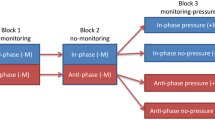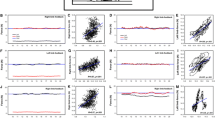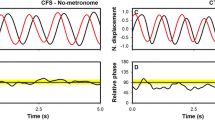Abstract
Two experiments were conducted to investigate the effects of attention and handedness on bimanual coordination in the context of a dynamical model of coordinated movements. Participants performed a bimanual, rhythmic Fitts’ law task in which the relative amount of attention directed to each task was manipulated by the relative difficulty associated with the pair of targets that each hand tapped. In both experiments, participants tended to lead with their preferred hand. The effects of attention, though, were mixed, which suggested that there was a combined effect of an attentional asymmetry and an asymmetry in the hands’ uncoupled frequency, both of which are captured in the dynamical model.












Similar content being viewed by others
References
Amazeen EL, Amazeen PG, Treffner PJ, Turvey MT (1997) Attention and handedness in bimanual coordination dynamics. J Exp Psychol Hum Percept Perform 23:1552–1560
Amazeen PG, Amazeen EL, Turvey MT (1998) Dynamics of intersegmental coordination. In: Rosenbaum DA, Collyer CE (eds) Timing of behavior: neural, psychological, and computational perspectives. MIT Press, Cambridge, MA, pp 237–259
Annett M (1967) The binomial distribution of right, mixed and left handedness. Q J Exp Psychol 19:327–333
Briggs GG, Nebes RD (1975) Patterns of hand preference in a student population. Cortex 11:230–238
Fitts PM (1954) The information capacity of the human motor system in controlling the amplitude of movement. J Exp Psychol 47:381–391
Franz EA (1997) Spatial coupling in the coordination of complex actions. Q J Exp Psychol 50A:684–704
Franz EA, Zelaznik HN, McCabe G (1991) Spatial topological constraints in a bimanual task. Acta Psychol 77:137–151
Haken H, Kelso JAS, Bunz H (1985) A theoretical model of phase transitions in human hand movements. Biol Cybern 51:347–356
Ibbotson NR, Morton J (1981) Rhythm and dominance. Cognition 9:125–135
Jeeves MA, Silver PH, Jacobson I (1988) Bimanual coordination in callosal agenesis and partial commissurotomy. Neuropsychologia 26:833–850
Kelso JAS (1984) Phase transitions and critical behavior in human bimanual coordination. Am J Physiol Regul Integr Comp Physiol 246:R1000–R1004
Kelso JAS, Southard DL, Goodman D (1979) On the coordination of two-handed movements. J Exp Psychol Hum Percept Perform 5:229–238
Kelso JAS, Putnam CA, Goodman D (1983) On the space–time structure of human interlimb co-ordination. Q J Exp Psychol 35A:347–375
Kelso JAS, Delcolle JD, Schöner G (1990) Action-perception as a pattern formation process. In: Jeannerod M (ed) Attention and performance XIII. Lawrence Erlbaum Associates, Hillsdale, NJ, pp139–169
Marteniuk RG, MacKenzie CL, Baba DM (1984) Bimanual movement control: information processing and interaction effects. Q J Exp Psychol 36A:335–365
Maxwell SE, Delaney HD (2000) Designing experiments and analyzing data. Lawrence Erlbaum Associates, Mahwah, NJ
Monno A, Temprado J-J, Zanone P-G, Laurent M (2002) The interplay of attention and bimanual coordination dynamics. Acta Psychol 110:187–211
Peters M (1981) Attentional asymmetries during concurrent bimanual performance. Q J Psychol 33A:95–103
Peters M (1985) Constraints in the coordination of bimanual movements and their expression in skilled and unskilled subjects. Q J Exp Psychol 37A:171–196
Peters M (1994) Does handedness play a role in the coordination of bimanual movement? In: Swinnen S, Heuer H, Massion J, Casaer P (eds) Interlimb coordination: neural, dynamical, and cognitive constraints. Academic, San Diego, CA, pp 595–612
Riley M, Amazeen EL, Amazeen PG, Treffner PJ, Turvey MT (1997) Effects of temporal scaling and attention on the asymmetric dynamics of bimanual coordination. Motor Control 1:263–283
Schöner G, Haken H, Kelso JAS (1986) A stochastic theory of phase transitions in human hand movement. Biol Cybern 53:442–452
Stucchi N, Viviani P (1993) Cerebral dominance and asynchrony between bimanual two-dimensional movements. J Exp Psychol Hum Percept Perform 19:1200–1220
Summers JJ, Semjen A, Carson RG, Thomas J (1995) Going around in circles: the dynamics of bimanual circling. In: Glencross DJ, Piek JP (eds) Motor control and sensory motor integration: issues and directions. Elsevier, Amsterdam, pp 231–253
Swinnen SP, Jardin K, Meulenbroek R (1996) Between-limb asynchronies during bimanual coordination: effects of manual dominance and attentional cueing. Neuropsychologia 34:1203–1213
Treffner PJ, Turvey MT (1995) Handedness and the asymmetric dynamics of bimanual rhythmic coordination. J Exp Psychol Hum Percept Perform 21:318–333
Treffner PJ, Turvey MT (1996) Symmetry, broken symmetry, and handedness in bimanual coordination dynamics. Exp Brain Res 107:463–478
Walter CB, Swinnen SP (1990) Asymmetric interlimb interference during the performance of a dynamic bimanual task. Brain Cogn 14:185–200
Welch JC (1898) On the measurement of mental activity through muscular activity and the determination of a constant of attention. Am J Physiol 1:283–306
Zanone P-G, Temprado J-J, Monno A (1999) Attentional load covaries with pattern stability in the control of bimanual coordination. In: Grealy MA, Thomson JA (eds) Studies in event perception and action V. Lawrence Erlbaum Associates, Hillsdale, NJ, pp 297–300
Zanone P-G, Monno A, Temprado J-J, Laurent M (2001) Shared dynamics of attentional cost and pattern stability in the control of bimanual coordination. Hum Mov Sci 20:765–789
Acknowledgments
The authors would like to acknowledge the contributions of Vanessa Brake, Jocelyn Estes, and Krista Shindledecker.
Author information
Authors and Affiliations
Corresponding author
Rights and permissions
About this article
Cite this article
Amazeen, E.L., Ringenbach, S.D. & Amazeen, P.G. The effects of attention and handedness on coordination dynamics in a bimanual Fitts’ law task. Exp Brain Res 164, 484–499 (2005). https://doi.org/10.1007/s00221-005-2269-y
Received:
Accepted:
Published:
Issue Date:
DOI: https://doi.org/10.1007/s00221-005-2269-y




